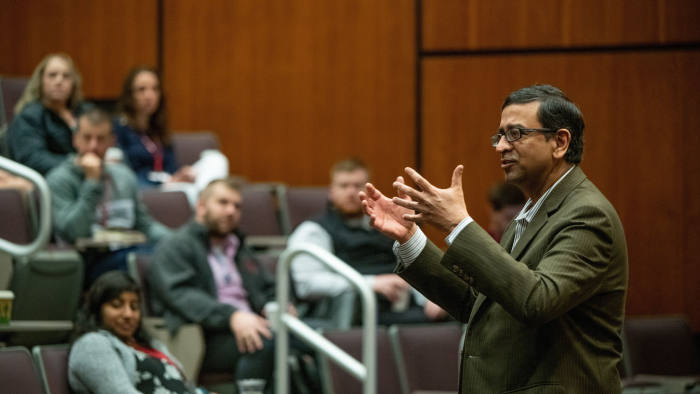For quite a few administrators eager to study for an MBA, the prospect of encounter-to-encounter networking would make on-campus programs the preferred solution. But the travel clampdown brought about by coronavirus, as well as the closure of some campuses, may force them to sample the alternative of on the net learning.
If they do, they will be reluctantly subsequent in the footsteps of the quite a few pupils — and instructors — who lengthy ago concluded that on the net study is the greatest in shape both of those for hectic existence and for consciences troubled by the environmental penalties of worldwide flights.
One particular significant-stage convert to on the net learning is Alison Fragale, a professor at the College of North Carolina’s Kenan-Flagler Company College who teaches lessons in negotiation from her residence in Chicago. On a usual early morning there she could possibly be sharing her insights with UNC-enrolled pupils across time zones ranging from dawn in California to night in Singapore.
Nevertheless she was to begin with doubtful about this tactic to enterprise instruction, it is, she states, a single of the “most rewarding” items she has finished. “It forces you to choose a important seem at your educating, and recognise how complacent you can come to be in the encounter-to-encounter classroom,” she points out.
For pupils drawn to an MBA in portion by the chance to create existence-lengthy networks through classroom periods, group get the job done and powerful socialising, the charm of undertaking the course remotely may seem to be confined. But a mixture of technological advances, changing cultural habits and diligently crafted programmes are encouraging to make on the net MBAs more interesting.

Improvements in digital communications have played a large portion. Prof Ramesh Venkataraman, chair of immediate MBA and MS programmes at Indiana University’s Kelley College of Company, states: “Seven a long time ago it was tough to teach on the net because of lousy bandwidth. The know-how meant you have been not able to simulate what you can do in the classroom.”
He recollects the requirement of “asynchronous” educating, where by course members independently posted penned comments to dialogue message boards and there was no interactivity. “Now it’s quite organic,” he states. “I would argue there are items we can do even improved than in a encounter-to-encounter classroom.”
Like his friends somewhere else, Prof Venkataraman employs digital “breakout rooms”, where by pupils maintain compact group discussions in genuine time and make notes in Google files that can be tracked systematically and shared with others. “You just can’t do that quite well in a genuine course, where by it’s all talking and you are not recording something,” he states.
He also argues that the use of penned on the net commentary can “even out the participating in field” for shy pupils: compared with a stay classroom dialogue, it allows them time to replicate and lead, somewhat than remaining drowned out by noisier members.
In the meantime culture has kept pace with know-how. Prof Fragale argues that the existing era of pupils, as well as professors of all ages, are more and more cozy with digital interaction. Many routinely use collaboration resources this kind of as Slack and Zoom at get the job done, as well as Facebook and WhatsApp in their social lives.
Martin Boehm, dean of IE Company College in Madrid (which is the FT’s companion in Headspring, an government growth enterprise), states that on the net learning can occasionally be “more personal” than the offline variety. “I remember a participant who said to his classmates ‘I permit you all into my household, my residence, you see my wife and my kids’,” he states.
He contrasts some of his encounter-to-encounter whole-time MBA pupils, who are “self-funded, soul seeking, and frequently do not know what they want to do”, with the greater perseverance of their on the net counterparts, who are usually doing work although learning. This genuine-earth publicity can also enrich course discussions. “We motivate them to provide worries from their get the job done into the course,” Prof Boehm states.
Similarly, the pressures of balancing study with get the job done and household existence can be powerful. But Prof Boehm states that fellow pupils frequently step in, share their own ordeals and motivate everyone who is struggling to adhere with the course. Educating employees also deliver assist, with a ratio at IE of a single faculty member to 35 pupils on the net — almost twice the stage of the whole-time classroom-centered MBA.

Student engagement is also strengthened by the simple fact that quite a few on the net companies even now insist on some “blended” learning — that is, learning that involves the student’s bodily presence. At Kenan-Flagler, that requires position in the course of “summit” gatherings on campus or in a metropolis abroad. And at IE, pupils are expected to invest two to three weeks on campus, including at the start of their course.
“They meet up with appropriate at the starting,” states Prof Boehm. “They make very good use of their time — they get the job done, study, social gathering genuinely tough. They do not sleep.” That supplies private contacts which can then be nurtured remotely, in chat rooms, course discussions and group get the job done.
Prof Venkataraman acknowledges that there are even now constraints to on the net learning. “Some powerful debates are tough to simulate — the softer aspects of encounter-to-encounter conversation with eye make contact with,” he states. “We may even now need to have improved know-how. But we are way past indicating that on the net is inferior.”



